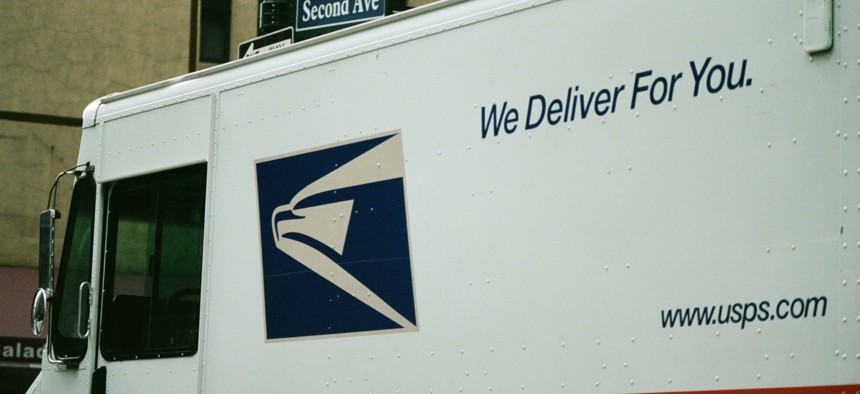Mail delays spike during USPS' busiest season
The Postal Service is delivering mail on time at its lowest rate since mid-2021.
The U.S. Postal Service is seeing delays of regular mail tick up consistently as the agency enters its busiest time of the year, with on-time performance slumping to its lowest level in more than two years.
USPS delivered 87.7% of First-Class mail on time in the week ending Nov. 17, the most recent data available, matching its rate for the first quarter of fiscal 2024 to that date. That marks a decline from 91% in the previous quarter and 92.5% in the same period last fiscal year.
On-time performance has reached its lowest rate since the summer of 2021, when postal management cited pandemic-related employee absenteeism and “street crime” for the significant delays. That followed delays so significant during the 2020 holiday season that eventually forced Postmaster General Louis DeJoy to concede his agency “missed our service standards by far and disappointed the nation."
On-time mail delivery has declined for most weeks of the current quarter and for two consecutive quarters. The delays come at a perilous time for the Postal Service and the mailing public, as the holidays mark its “peak season” and is the agency’s most profitable period of the year. They also come after, in a controversial move, DeJoy in 2021 slowed down USPS service standards to give the agency additional days to deliver some mail.
Albert Ruiz, a Postal Service spokesperson, pointed to two specific incidents that have exacerbated delays: the agency insourced several Surface Transfer Centers—buildings that serve as staging areas where mail gets dropped off before it gets rerouted elsewhere—previously managed by third parties and a two-week shutdown of a facility in St. Louis after an illegally shipped package caused a mercury spill at the plant.
Ongoing supply chain issues have added volume to the postal system, Ruiz said, also contributing to delays. He added DeJoy’s 10-year Delivery for America plan to restructure the Postal Service, including through modernizing facilities, building new facilities, adding new processing machines and improving the transportation network, could lead to some issues in meeting the slowed down standards.
“Our aim is to keep any temporary disruptions to service resulting from these changes to a minimum,” Ruiz said. “When there are service impacts, we respond rapidly to resolve those issues.”
Postal management has acknowledged it could run into some setbacks as it implements broad changes to its network in the midst of its busiest period, but has expressed confidence it can operate without issue and with far less seasonal staff than it typically hires. Ruiz expressed confidence the delays would not lead to a crisis like USPS experienced during the 2020 holidays.
“The Postal Service is strongly positioned to handle the holiday mail and package surge by leveraging our significant investments in our people, infrastructure, delivery network and technology,” he said. He added the Postal Service is delivering 96.5% of mail within one day of its service standard, meaning many of the delays are not for extended periods of time.
Sen. Gary Peters, D-Mich., who chairs the Senate Homeland Security and Governmental Affairs Committee that has oversight of the Postal Service, on Tuesday wrote letter to DeJoy asking for detailed plans and assessments of the agency's network changes and its impact. Peters asked how USPS has evaluated which facilities to consolidate, the fallout for employees and what the effects will be on service.
"I am concerned about the pace of these changes and urge USPS to provide full transparency on its plans moving forward," Peters said. "It is essential that USPS study and disclose details about the impacts of any changes, including impacts on service. I urge the Postal Service to fully study the impacts of early facility changes before moving forward with plans."
Several postal stakeholders representing various factions of the mailing community said the data backs up what they have seen or heard from members and clients. Dave Lewis, president of SnailWorks, a company that helps businesses launch and track mail ad campaigns, tracks millions of mail pieces each week and his data show delays increasing since the summer.
“We have definitely seen a decline in First-Class on-time performance, and it seems to be a trend,” Lewis said, noting it is part of a longer pattern. “2023 is worse than 2022, and 2022 was worse than 2021, even with the Postal Service making it easier to be ‘on time’ in October 2021.”
Marketing mail has performed well with on-time delivery remaining high, though those users typically bypass much of the Postal Service’s network by bundling their own mail and bringing it to a destination facility. USPS began issuing its own weekly reports of its performance in 2021, though it fought efforts to require their release.
Steve Kearney, executive director of the Alliance of Nonprofit Mailers, said while postal management is pointing to temporary causes for the current delays, “time will tell whether the service gets back to where it should be.” He speculated the Postal Service’s focus on its package business could lead to deprioritized mail being slowed down and suggested understaffing could play a role as well.
“In general, it appears to mailers that USPS is favoring growth in packages while assuming that the decline in mail volume is inevitable,” Kearney said.
Many mailers have particularly decried worse service as the Postal Service makes using the mail more expensive. DeJoy has used new authority to raise rates faster than inflation five times since taking office in 2020.








